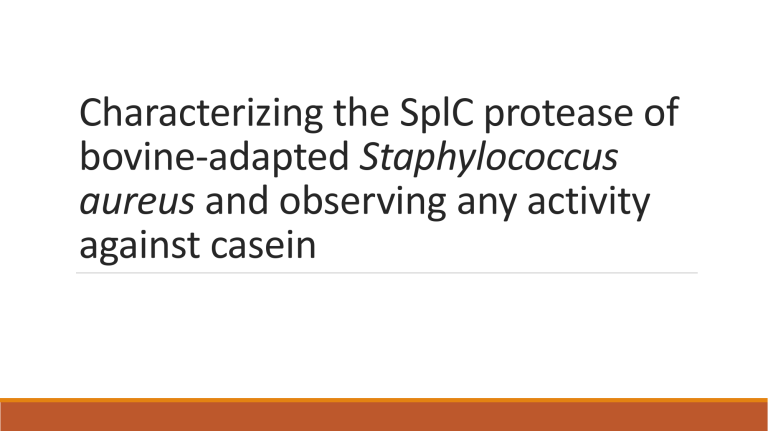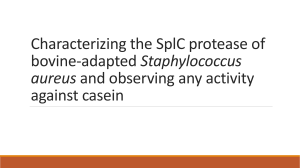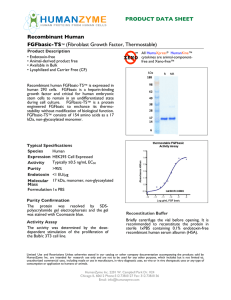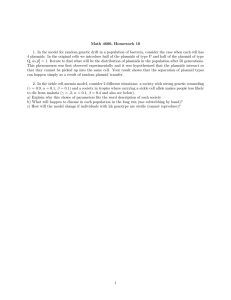
Characterizing the SplC protease of bovine-adapted Staphylococcus aureus and observing any activity against casein 9 different S. aureus strains were tested for casein digestion and milk curdling after which I chose the two strains: AR802 and RF122 for further experimentation. 70 kDa 55 kDa 40 kDa An SDS-PAGE was performed with the following S aureus strains: VI54661, VI54649, VI54665, VI54655, RF287, 283, RF122, 114, AR802 . This was done to separate and identify the proteases via comparison of the band size to the protein ladder. The zymography technique with a gel consisting of casein was then used to detect any proteolytic activity by proteases against casein for each of the strains. The zones of clearance in the casein gel were used to give an estimate of which S. aureus proteases were able to digest casein. As seen in the zymogram gel below, the RF122 produced big zones of clearances in the zymogram, indicating large digestive activity of casein. The two strains of choice were RF122 and AR802 and hence were used for further investigation and the cloning of SplC protease. 35 kDa 25kDa 70 kDa 55 kDa 40 kDa 35 kDa 25kDa Preparing for DNA cloning Initially an analysis of lineage-specific genes of SplC in both AR802 and RF122 was done which helped in designing specific forward and reverse primers for two different plasmids. The two plasmids used in the cloning were pCT::vwb which was his-tagged (and lacking a STOP codon) and pALC 2073 without a tag. Preparation for cloning was commenced by extracting genomic DNA from the two strains AR802 and RF122 by lysing the bacteria samples with lysozyme and lysostaphin. The Plasmids were then extracted and loaded onto agarose gel to confirm plasmid DNA presence after which they were extracted from the gel??. Next, a PCR was performed of the mastermix containing the extracted gDNA, designed primers, DNA polymerase and dNTPs. The PCR products were then purified. State WHY Cloning For 3-day faster cloning method, the Gibson assembly technique was used to insert the purified PCR products into the vector plasmid digest. The DNA fragments from the PCR product were assembled into the two plasmids using a thermocycler. To produce large quantities of the plasmids with the gene of interest, IM08B E. coli competent cells were made and then transformed with the assembled fragments from the Gibson assembly via heat shock. The cells containing the plasmid and gene of interest were ampicillin resistant and therefore grew on ampicillin antibiotic plates. For additional verification of plasmid presence in E. coli, colony PCR was done to screen the colonies containing the desired genetic construct and viewed on agarose gel. The plasmid from the chosen colony was extracted from overnight E. coli cultures and electro transformed them into USA 300 Δ proteases S. aureus strain. The USA300 Δ proteases electrocompetent cells containing the plasmid + SplC gene were Chloramphenicol resistant and therefore had the ability to grow onto the plates. To further confirm that the plasmids were successfully taken up by the S. aureus samples, they were first lysed, and a colony PCR was performed to be observed on agarose gel. Successful results can be seen on the left. Induction 24hrs Induction 2hrs Results Next, to identify whether the SplC protease was being expressed, the anhydrotetracycline was added to the samples for a 24-hour induction before performing an SDS-PAGE. From previous calculations, the predicted protein molecular weight for SplC_AR802 was 22.5 kDa and 22.4 kDa for SplC_RF122. However as seen in the figure on the left, no additional bands were displayed in the SDS-PAGE gel for the transformed USA 300 strains compared to the plasmid pALC control (did not contain SplC gene insert), and subsequently no zones of clearances were formed in the zymogram either. It was possible that the SplC protein was being expressed at low levels. Hence, I repeated the experiment a second time by reducing induction time to 2 hours instead of overnight and the samples were filter sterilised and centrifuged. Both the concentrated supernatant and pellet were used test on the SDS-PAGE gel. The third time I performed an ethanol precipitation of the samples to precipitate the proteins before visualizing them on the SDS-PAGE gels. Both these changes did not produce the required sized bands on the gel. Ethanol Precipitation Results and Conclusion Additionally, a milk curdling experiment was done by adding milk into each sample and inspected for milk curdling after 24 hours. However, the results presented no milk curdling from pALC::SplC AR802/RF122 and pCT::SplC AR802/RF122. Lastly, I resorted to using a his-tag antibody to perform a western blot in order to detect the his-tagged SplC protein from the pCT::SplC AR802 and RF122 samples. The results did not reveal any bands on the western blot for the his-tagged plasmid as seen on the right. The results obtained from multiple tests concluded that the SplC protein was not expressed by both AR802 and RF122 S. aureus strains despite the strains having taken up the plasmid. I would like to thank Professor Ross Fitzegerald for providing me with this invaluable learning experience in his laboratory as well as thank Dr. Amy Pickering for her teaching and guidance throughout the project!





